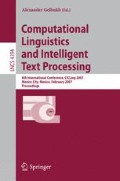Abstract
For a robot to make effective and friendly interaction with human users, it is important to keep track of emotional changes in utterance properly. Emotions have traditionally been characterized by intuitive but atomic categories or as points in evaluation-activity dimensions. However, this characterization falls short of capturing subtle emotional changes either in narration or in text, where the vast majority of information is presented with a host of linguistic constructions that convey emotional information. We propose a novel representation scheme for emotions, so that such important features as duration, target and intensity can also be treated as first-class citizens and systematically accounted for. We argue that it is with this new mode of representation that the subtlety of the emotional flow in utterance can be properly addressed. We use this representation to encode the emotional states and intentions of characters in the drama scripts for soap opera and describe how it is utilized in conjunction with parsing for lexicalized grammars.
Access this chapter
Tax calculation will be finalised at checkout
Purchases are for personal use only
Preview
Unable to display preview. Download preview PDF.
References
Ekman, P.: Basic emotions. In: Dalgleish, T., Power, J.M. (eds.) Handbook of Cognition & Emotion, New York, pp. 301–320 (1999)
Osgood, C.E., May, W.H., Miron, M.S.: Cross-cultural Universals of Affective Meaning. University of Illinois Press, Urbana (1975)
Ortony, A., Clore, G.L., Collins, A.: The Cognitive Structure of Emotions. Cambridge University Press, Cambridge (1988)
Abrilian, S., Devillers, L., Buisine, S., Martin, J.C.: EmoTV1: Annotation of Real-life Emotions for the Specification of Multimodal Affective Interfaces. In: Proceedings of 11th International Conference on Human-Computer Interaction (HCI International), pp. 22–27 (2005)
Kipp, M.: Anvil - A Generic Annotation Tool for Multimodal Dialogue. In: Proceedings of Eurospeech’01, pp. 1367–1370 (2001)
Vidarascu, L., Devillers, L.: Real-life Emotion Representaion and Detection in Call Centers Data. In: Tao, J., Tan, T., Picard, R.W. (eds.) ACII 2005. LNCS, vol. 3784, pp. 739–746. Springer, Heidelberg (2005)
Douglas-Cowie, E., Devillers, L., Martin, J., Cowie, R., Savvidou, S., Abrilian, S., Cox, C.: Multimodal Databases of Everyday Emotion: Facing up to Complexity. In: Proceedings of INTERSPEECH 2005, Lisbon, Portugal, September, pp. 813–816 (2005)
Cowie, R., Douglas-Cowie, E., Savvidou, S., McMahon, E., Sawey, S., Schroder, M.: “FEELTRACE”: An Instrument for Recording Perceived Emotion in Real Time. In: ISCA Workshop on Speech & Emotion, pp. 19–24 (2000)
Liu, H., Liberman, L., Selker, T.: A Model of Textual Affect Sensing using Real-World Knowledge. In: Proceedings of International conference on User Interface, Miami, Florida, USA, January, pp. 125–132 (2003)
Zhe, X., Boucouvalas, A.: Text-to-Emotion Engine for Real Time Internet Communication. In: Proceedings of the International Symposium on Communication Systems, Networks and DSPs, Staffordshire University, UK, July, pp. 164–168 (2002)
Fitrianie, S., Wiggers, P., Rothkarantz, L.J.M.: A Multi-modal Eliza Using Natural Language Processing and Emotion Recognition. In: Matoušek, V., Mautner, P. (eds.) TSD 2003. LNCS (LNAI), vol. 2807, pp. 394–399. Springer, Heidelberg (2003)
Wilson, T., Wiebe, J., Hoffman, P.: Recognizing contextual polarity in phrase-level sentiment analysis. In: Proceedings of HLT/EMNLP, Vancouver, October, pp. 347–354 (2005)
Litman, D.J., Forbes-Riley, K.: Predicting Student Emotions in Computer-Human Tutoring Dialogue. In: Proceedings of the 42nd Annual Meeting of the Association for Computational Linguistics, Barcelona, Spain, July, pp. 352–359 (2004)
Ahn, S., Lee, S., Kwon, O.: Activation Dimension: A Mirage in the Affective Space. Korean J. of Social Psychology 7(1), 107–123 (1993)
Gabbay, D.M., Kurucz, A., Wolter, F., Zakharyaschev, M.: Many-Dimensional Modal Logics: Theory and Applications. Elsevier Science B.V, Amsterdam (2003)
Steedman, M.: The Syntactic Process. MIT Press, Cambridge (2000)
The Humaine Research Group: the Emotion Annotation and Representation Language specification (2006), http://emotion-research.net/earl/index_html
Author information
Authors and Affiliations
Editor information
Rights and permissions
Copyright information
© 2007 Springer-Verlag Berlin Heidelberg
About this paper
Cite this paper
Min, HJ., Park, J.C. (2007). Representing Emotions with Linguistic Acuity. In: Gelbukh, A. (eds) Computational Linguistics and Intelligent Text Processing. CICLing 2007. Lecture Notes in Computer Science, vol 4394. Springer, Berlin, Heidelberg. https://doi.org/10.1007/978-3-540-70939-8_31
Download citation
DOI: https://doi.org/10.1007/978-3-540-70939-8_31
Publisher Name: Springer, Berlin, Heidelberg
Print ISBN: 978-3-540-70938-1
Online ISBN: 978-3-540-70939-8
eBook Packages: Computer ScienceComputer Science (R0)

